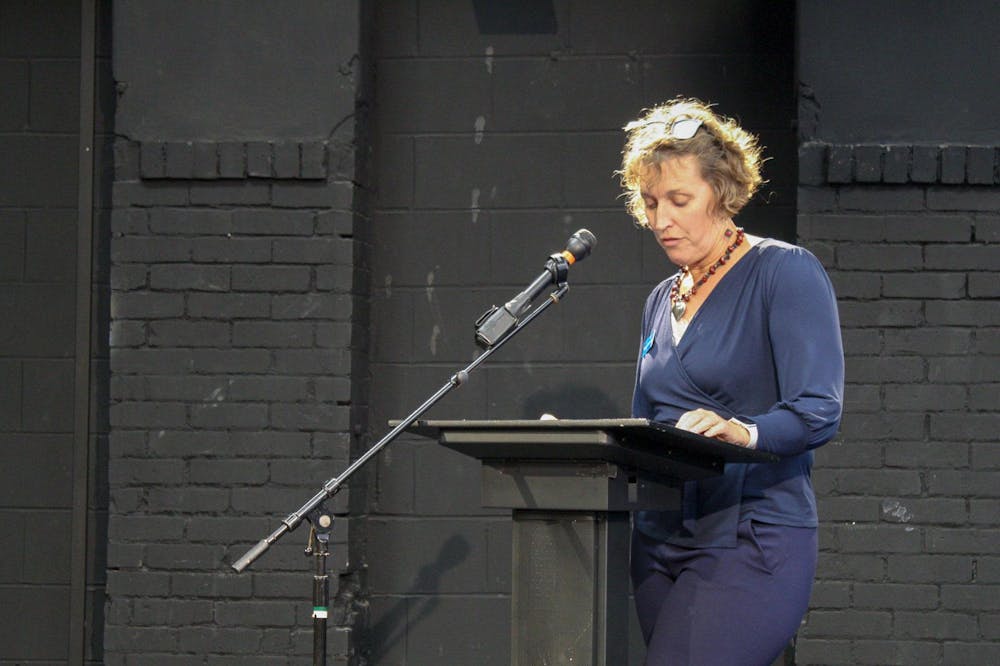City engineers and department leaders updated the public about the future Hopewell Neighborhood’s sustainability efforts, parks and recreation developments and inclusion of the arts Wednesday at the John Waldron Arts Center.
Jane Kupersmith, Bloomington’s director of economic and sustainable development, kicked off the presentation by sharing the history of the Hopewell Neighborhood and details from the city’s master plan for the development.
The name of the development stems from Hopewell House, a 10-room house that Bloomington’s Local Council of Women bought in 1905. The house served as one of the city’s first hospitals, according to the city website.
Kupersmith reviewed how the city made an effort to include community voices in the planning stages of the neighborhood. The city conducted public forums and one-on-one interviews with over 150 members of the public, ranging from religious leaders to former mayors, to gain input.
The event got off to a rough start with technical difficulties. Kupersmith’s presentation slides, which were being screen recorded by Zoom, were somewhat overshadowed by the visible Zoom chat log on the bottom of the screen.
Members of the public joined the Zoom meeting and some users spammed racial slurs and links to pornographic videos that were visible on screen to the roughly 50 people in attendance.
“I’m not going to look at that,” Kupersmith said.
After Kupersmith finished her section of the presentation, which took around 15 minutes, the city leaders took a brief recess to fix the issue.
Kendall Knoke, a city project engineer, shared the Hopewell East and Hopewell West sections of the neighborhood are closest to finished. Knoke expects Hopewell West to finish construction in 2025.
Bloomington Parks and Recreation Department representative Tim Street discussed the city’s plans for Hopewell Commons, a one-acre recreational space in the center of the neighborhood. Street said the space will accommodate 126 new trees and 17,000 square feet of native plants.
Hopewell Commons will be outfitted with security cameras, Wi-Fi and electric outlets for food trucks. Temporarily, the park will host to three pickleball courts. Street said the courts will find a permanent home somewhere else, but did not specify where.
“(There is) a lot of desire for pickleball in the community,” Street said.
The city originally intended to include a water feature in the park, but Street said the structure was cut from the plan.
Holly Warren, the city’s assistant director of the arts, spoke about the city’s funding mechanism dedicated to arts.
“The city has this awesome ordinance that says anytime we undertake a large-scale capital project, 1% of that project’s public construction budget has to go towards the arts,” Warren said.
The art department’s 1% allocation is around $190,000 for the Hopewell project. The city held a contest for local artists’ work to be featured in the new neighborhood. Ultimately, the city chose Jon Racek, a design professor at Indiana University, to design a piece.
Racek’s piece is called “Undulate.” It will serve as a play structure and seating for park-goers in Hopewell Commons.
During the Q&A section of the presentation, multiple members of the audience raised concerns about housing affordability in the neighborhood.
She said she won’t know exact price points for housing options until the city chooses developers for the buildings, but the project targets a minimum of 20% of its housing units to be affordable.
“It is just part of the development process,” Kupersmith said regarding the concerns.
Kupersmith added that “a lot” of the affordable housing buildings will be recipients of low-income housing tax credits, which have “strict” compliance programs.
One audience member brought up Summit Hill Community Land Trust, a shared-ownership project from the Bloomington Housing Authority that aims to keep housing affordable, and asked why Hopewell can’t follow the same model.
The Summit Hill Community Land Trust works by separating ownership of a plot of land from the structure on the land. Money in the trust is governed by Summit Hill Community Development Corporation.
Bloomington Mayor Kerry Thomson said that without lenders to contribute to a land trust, the city is unable to guarantee long-term affordability like that of the Summit Hill Community Land Trust.
The mayor suggested that low-income housing tax credits would be one of the ways the city looks to tackle the issue.
“I know Bloomington is creative enough that we can find some good solutions to make sure that we get a good mix of incomes as Hopewell,” Thomson said.




